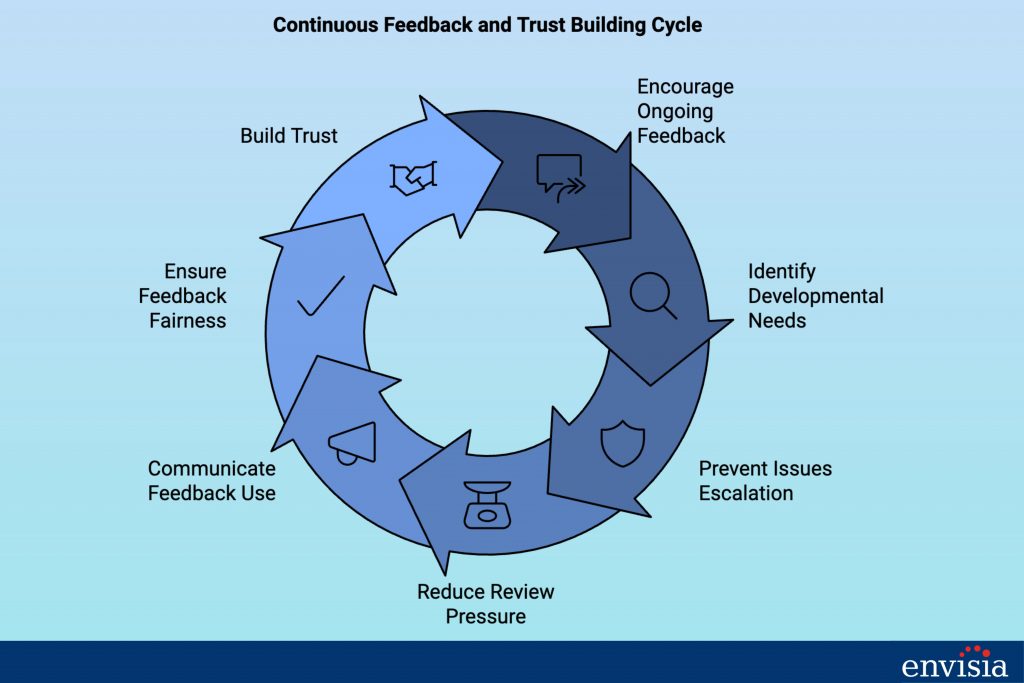The 360-degree feedback system frequently faces criticism for issues related to confidentiality and bias. These problems can compromise the feedback process, leading to skewed or dishonest evaluations. However, thoughtful improvements—like ensuring confidentiality, training feedback providers on competencies, and fostering a culture of continuous feedback—help organizations tackle these challenges and build a more trustworthy and effective performance management system.
This blog explores privacy concerns in the 360-degree feedback process, how they impact feedback accuracy and offers actionable solutions to improve trust and honesty in your organization’s feedback culture.
We’ve all heard the saying, ‘feedback is a gift,’ yet many of us have experienced feedback that feels vague, biased, or unfair. In 360-degree feedback systems, the most frequent criticism stems from concerns about confidentiality, leading to skewed or nonconstructive responses. Without honest input, employees and managers lose out on valuable insights.
When employees worry that their responses could be traced back to them, they tend to hold back from providing the honest, constructive feedback needed for growth. This undermines the purpose of a 360 feedback system—delivering well-rounded, multi-perspective insights on employee performance.
But here’s the good news: with thoughtful adjustments, we can address these concerns and transform feedback into a tool that actually improves productivity and employee engagement.
Key Takeaways
- Lack of confidentiality in a 360 review process can lead to dishonest feedback, undermining its effectiveness.
- Competency bias and varying feedback standards can distort performance reviews, affecting fair appraisals.
- Improving confidentiality and creating a culture of continuous feedback can foster more honest and valuable feedback.

Overview of the 360-Degree Feedback System
The 360 degree feedback system has become a widely used performance management tool in organizations today. It stands out because it gathers feedback from a variety of sources—managers, peers, subordinates, and sometimes even clients. This multi-rater feedback is designed to provide a well-rounded view of an employee’s strengths and weaknesses, making it more comprehensive than standard performance appraisal systems.
In a 360 review, the goal is to get feedback on various competencies that affect job performance. By receiving diverse feedback from different perspectives, employees can identify areas for improvement that may not be visible through direct supervisor reviews alone. However, despite its benefits, the system isn’t without its flaws.
Common Criticism: Lack of Confidentiality and Honest Feedback
Why Confidentiality is a Concern in 360-Degree Feedback
One of the most common criticisms of the 360 degree evaluation system is the concern over confidentiality. When employees believe their feedback might be traced back to them, or may be used to punish them, they are less likely to provide honest feedback. This fear can result in vague, nonconstructive, or overly positive evaluations to avoid potential fallout.
For 360-degree feedback to work effectively, employees need to trust that their feedback will remain anonymous. Here’s how organizations can address confidentiality concerns:
- Implement anonymous survey tools: Use secure, third-party platforms that ensure anonymity, allowing employees to provide feedback without fear of reprisal.
- Communicate privacy policies clearly: Regularly remind employees that the feedback received will remain confidential, reinforcing this message through internal communications and training sessions.
- Separate feedback from performance evaluations: Ensure feedback is developmental, not punitive. When employees know their input won’t be used against them, they’re more likely to be honest.
- Rotate feedback raters regularly: A rotation system can reduce concerns of bias and retaliation, as it becomes harder to trace feedback to specific individuals.
Impact on Continuous Feedback and Trust
Confidentiality concerns don’t just impact a one-off 360 review; they can have long-term effects on continuous feedback in an organization. If employees don’t trust the feedback process, they may hesitate to engage in future reviews or provide meaningful feedback. A lack of trust can also stifle employee engagement, as individuals may feel that their honest opinions will not be valued or could even be used to punish the person being rated.
In this context, companies must prioritize creating an environment where ongoing feedback feels safe and constructive. By ensuring privacy, organizations can help build a culture of openness and trust.

Competency Bias and Varying Standards in Feedback
Different Competency Levels Among Feedback Providers
Competency bias arises when feedback providers are not equally skilled in evaluating performance. For example, a peer with less experience may provide feedback that doesn’t reflect a clear understanding of the competencies required for the role. To mitigate this, organizations can:
- Offer rater training: Educate those providing feedback on objectively assessing competencies, with clear guidelines to minimize bias and inconsistency.
- Use competency frameworks: Provide raters with structured frameworks that clearly outline what to assess. This ensures feedback is aligned with the organization’s goals and not based on personal opinions or misunderstandings of the role.
- Incorporate self-assessments: Including employee self-assessments alongside peer feedback helps provide a more balanced view, allowing for a comparison of internal and external perspectives.
- Cross-check feedback: Designate a manager or HR professional to review feedback from multiple sources for consistency and fairness before it is shared with the employee.
Feedback from individuals with different levels of competency can skew results, leading to unfair appraisals. It’s essential to acknowledge that not all raters will have the same knowledge or perspective, which can create discrepancies in the feedback provided.
Bias in Gathering Feedback
Personal bias is another factor that can distort feedback in a 360-degree review system. Whether intentional or not, biases such as favoritism, past conflicts, or personal relationships can influence the evaluations provided by raters. This introduces a layer of subjectivity that can impact the accuracy of the feedback and, ultimately, the effectiveness of the performance management system.
By addressing these biases and ensuring a more standardized feedback process, organizations can improve the fairness of their 360-degree reviews.
Improving the 360 Degree Feedback System
Ensuring Confidentiality in Feedback Collection
To overcome the criticism of confidentiality, organizations can implement best practices that ensure feedback remains anonymous. Using secure, anonymous survey tools can promote honest feedback without fear of identification. When employees feel comfortable giving feedback without fear of repercussions, the quality and candor of the feedback will improve, leading to more effective performance evaluations.

Competency-Based Feedback for Fair Performance Reviews
Another way to improve the fairness of the 360 review system is by ensuring that feedback providers are competent in delivering reviews. This can be achieved through training that focuses on how to evaluate competencies objectively. Clear competency frameworks can also be introduced to ensure that feedback is aligned with organizational goals and expectations, leading to more accurate and useful performance reviews.
The Role of Continuous Feedback in Overcoming Criticisms

Fostering a Culture of Continuous (Ongoing) Feedback
One way to mitigate the impact of bias or confidentiality concerns, in an evaluation process, is to foster a culture of continuous (ongoing) feedback. Rather than waiting for an annual review, organizations should encourage ongoing feedback, which can help to identify developmental needs early and prevent small issues from escalating. Continuous feedback can also reduce the pressure of a single performance review, allowing for more genuine, constructive feedback over time.
Building Trust Through Transparent Feedback Processes
Transparency is key when it comes to building trust in the feedback process. By clearly communicating how feedback will be used, who will have access to it, and ensuring that it won’t be used to punish the person being rated, organizations can encourage more honest feedback. Establishing clear guidelines for the feedback process will create a sense of fairness and trust across the organization.
Conclusion
As organizations increasingly rely on 360-degree feedback for performance management, addressing these common criticisms is essential for maximizing its value. By implementing strategies such as ensuring confidentiality, reducing bias through structured feedback processes, and fostering a culture of continuous feedback, organizations can build a more trustworthy system. Ultimately, when employees feel safe and valued, they’re more likely to offer honest, constructive feedback that contributes to their growth and the organization’s success. By doing so, they can ensure that feedback is a valuable tool for improving employee performance and engagement across the organization.
